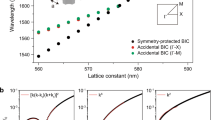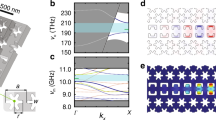Abstract
The effects of cavity quantum electrodynamics (QED), caused by the interaction of matter and the electromagnetic field in subwavelength resonant structures, have been the subject of intense research in recent years1. The generation of coherent radiation by subwavelength resonant structures has attracted considerable interest, not only as a means of exploring the QED effects that emerge at small volume, but also for its potential in applications ranging from on-chip optical communication to ultrahigh-resolution and high-throughput imaging, sensing and spectroscopy. One such strand of research is aimed at developing the ‘ultimate’ nanolaser: a scalable, low-threshold, efficient source of radiation that operates at room temperature and occupies a small volume on a chip2. Different resonators have been proposed for the realization of such a nanolaser—microdisk3 and photonic bandgap4 resonators, and, more recently, metallic5,6, metallo-dielectric7,8,9,10 and plasmonic11,12 resonators. But progress towards realizing the ultimate nanolaser has been hindered by the lack of a systematic approach to scaling down the size of the laser cavity without significantly increasing the threshold power required for lasing. Here we describe a family of coaxial nanostructured cavities that potentially solve the resonator scalability challenge by means of their geometry and metal composition. Using these coaxial nanocavities, we demonstrate the smallest room-temperature, continuous-wave telecommunications-frequency laser to date. In addition, by further modifying the design of these coaxial nanocavities, we achieve thresholdless lasing with a broadband gain medium. In addition to enabling laser applications, these nanoscale resonators should provide a powerful platform for the development of other QED devices and metamaterials in which atom–field interactions generate new functionalities13,14.
This is a preview of subscription content, access via your institution
Access options
Subscribe to this journal
Receive 51 print issues and online access
$199.00 per year
only $3.90 per issue
Buy this article
- Purchase on Springer Link
- Instant access to full article PDF
Prices may be subject to local taxes which are calculated during checkout




Similar content being viewed by others
References
Berman, P., ed. Cavity Quantum Electrodynamics (Academic, 1994)
Noda, S. Seeking the ultimate nanolaser. Science 314, 260–261 (2006)
McCall, S. L., Levi, A. F. J., Slusher, R. E., Pearton, S. J. & Logan, R. A. Whispering-gallery mode microdisk lasers. Appl. Phys. Lett. 60, 289–291 (1992)
Painter, O. et al. Two-dimensional photonic band-gap defect mode laser. Science 284, 1819–1821 (1999)
Hill, M. T. et al. Lasing in metallic-coated nano-cavities. Nature Photon. 1, 589–594 (2007)
Walther, C., Scalari, G., Amanti, M. I., Beck, M. & Faist, J. Microcavity laser oscillating in a circuit-based resonator. Science 327, 1495–1497 (2010)
Mizrahi, A. et al. Low threshold gain metal coated laser nanoresonators. Opt. Lett. 33, 1261–1263 (2008)
Nezhad, M. P. et al. Room-temperature subwavelength metallo-dielectric lasers. Nature Photon. 4, 395–399 (2010)
Yu, K., Lakhani, A. & Wu, M. C. Subwavelength metal-optic semiconductor nanopatch lasers. Opt. Express 18, 8790–8799 (2010)
Ding, Q., Mizrahi, A., Fainman Y & Lomakin, V. Dielectric shielded nanoscale patch laser resonators. Opt. Lett. 36, 1812–1814 (2011)
Noginov, M. A. et al. Demonstration of a spaser-based nanolaser. Nature 460, 1110–1112 (2009)
Oulton, R. F. et al. Plasmon lasers at deep subwavelength scale. Nature 461, 629–632 (2009)
Burgos, S. P., deWaele, R., Polman, A. & Atwater, H. A. A single-layer wide-angle negative-index metamaterial at visible frequencies. Nature Mater. 9, 407–412 (2010)
Jacob, Z. & Shalaev, V. M. Plasmonics goes quantum. Science 334, 463–464 (2011)
Vahala, K. J. Optical microcavities. Nature 424, 839–846 (2003)
Yokoyama, H. Physics and device applications of optical microcavities. Science 256, 66–70 (1992)
Bjork, G. & Yamamoto, Y. Analysis of semiconductor microcavity lasers using rate equations. IEEE J. Quantum Electron. 27, 2386–2396 (1991)
Baida, F. I., Belkhir, A. & Van Labeke, D. Subwavelength metallic coaxial waveguides in the optical range: Role of the plasmonic modes. Phys. Rev. B 74, 205419 (2006)
Feigenbaum, E. & Orenstein, M. Ultrasmall volume plasmons, yet with complete retardation effects. Phys. Rev. Lett. 101, 163902 (2008)
Benzaquen, R. et al. Alloy broadening in photoluminescence spectra of GaxIn1−xAsyP1−y lattice matched to InP. J. Appl. Phys. 75, 2633–2639 (1994)
Bayer, M. et al. Inhibition and enhancement of the spontaneous emission of quantum dots in structured microresonators. Phys. Rev. Lett. 86, 3168–3171 (2001)
Vuckovic, J., Painter, O., Xu, Y., Yariv, A. & Scherer, A. Finite-difference time-domain calculation of the spontaneous emission coupling factor in optical microcavities. IEEE J. Quantum Electron. 35, 1168–1175 (1999)
Schawlow, A. L. & Townes, C. H. Infrared and optical masers. Phys. Rev. 112, 1940–1949 (1958)
Henry, C. Theory of the linewidth of semiconductor lasers. IEEE J. Quantum Electron. 18, 259–264 (1982)
Björk, G., Karlsson, A. & Yamamoto, Y. On the linewidth of microcavity lasers. Appl. Phys. Lett. 60, 304–306 (1992)
Rice, P. R. & Carmichael, H. J. Photon statistics of a cavity-QED laser: a comment on the laser-phase-transition analogy. Phys. Rev. A 50, 4318–4329 (1994)
Pedrotti, L. M., Sokol, M. & Rice, P. R. Linewidth of four-level microcavity lasers. Phys. Rev. A 59, 2295–2301 (1999)
Roy-Choudhury, K. & Levi, A. F. J. Quantum fluctuations and saturable absorption in mesoscale lasers. Phys. Rev. A 83, 043827 (2011)
Strauf, S. et al. Self-tuned quantum dot gain in photonic crystal lasers. Phys. Rev. Lett. 96, 127404 (2006)
Chang, S. W. & Chuang, S. L. Fundamental formulation for plasmonic nanolasers. IEEE J. Quantum Electron. 45, 1014–1023 (2009)
Acknowledgements
We acknowledge support from the Defense Advanced Research Projects Agency (DARPA), the National Science Foundation (NSF), the NSF Center for Integrated Access Networks (CIAN), the Cymer Corporation and the US Army Research Office. M. Khajavikhan thanks the personnel of the UCSD Nano3 facilities for their help and support, T. Javidi and J. Leger for technical discussions regarding the analysis of the data and profile of the beam, and graduate student J. Shane for her help with editing the document.
Author information
Authors and Affiliations
Contributions
M. Khajavikhan conceived the idea of thresholdless laser using nanoscale coaxial structures. The electromagnetic design, simulation, and analysis of the structures were carried out by M. Khajavikhan, A.M. and V.L. Fabrication of the devices was carried out by M. Khajavikhan and J.H.L. The optical measurements were performed by A.S. and M. Khajavikhan. The rate equation model was developed by M. Katz. The optical characterization and analysis of laser behaviour was carried out by M. Khajavikhan, M. Katz, A.M., B.S. and Y.F. The manuscript was written by M. Khajavikhan, with contributions from A.M., M. Katz, Y.F., A.S., B.S. and V.L.
Corresponding author
Ethics declarations
Competing interests
The authors declare no competing financial interests.
Supplementary information
Supplementary Information
This file contains Supplementary Text and Data, Supplementary Figures 1-14 with legends and additional references. (PDF 1588 kb)
Rights and permissions
About this article
Cite this article
Khajavikhan, M., Simic, A., Katz, M. et al. Thresholdless nanoscale coaxial lasers. Nature 482, 204–207 (2012). https://doi.org/10.1038/nature10840
Received:
Accepted:
Published:
Issue Date:
DOI: https://doi.org/10.1038/nature10840
This article is cited by
-
Frequency pushing enhanced by an exceptional point in an atom–cavity coupled system
Scientific Reports (2024)
-
Ultra-small low-threshold mid-infrared plasmonic nanowire lasers based on n-doped GaN
Discover Nano (2023)
-
Group III–V element behaviour as a gain material in nano-lasers
Journal of Optics (2023)
-
Ultra-low threshold lasing through phase front engineering via a metallic circular aperture
Nature Communications (2022)
-
Ultralow-threshold laser using super-bound states in the continuum
Nature Communications (2021)
Comments
By submitting a comment you agree to abide by our Terms and Community Guidelines. If you find something abusive or that does not comply with our terms or guidelines please flag it as inappropriate.



